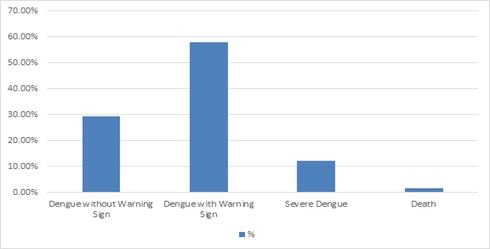The paradigmatic shift in the clinical profile of dengue patients: a prospective observational study from a tertiary care center in north India
Abstract
Background: Dengue a vector-borne viral disease transmitted by mosquito and has several complications causing fatalities and a bad impact on society. The paucity of studies in Uttar Pradesh and lack of epidemiological data necessitated to take up this prospective study. Thus, the current study looked into the causes of heavy prevalence, urban v/s rural ratio, gender difference, various complications to formulate a strategy to limit the severity of the disease by early diagnosis and rapid intervention. The fever caused by dengue is characterized by body ache, petechial rashes, myalgia, and nausea and vomiting. There can be varied manifestations of dengue involving the lung, pleura, peritoneum, pericardium, and complications of liver, kidney, brain, muscle, eye, and other organs. The disease is characterized by thrombocytopenia, dehydration, bleeding tendencies, shock, and multiorgan dysfunction. Current estimates reports about 40% (2.5-3 billion) of the world population are at risk.
Purpose: The study is aimed at detecting clinical signs and symptoms of patients with dengue fever presenting to TMU teaching hospital between January 2019 to December 2019.
Material and Methods: A prospective observational study was undertaken in serologically confirmed cases of dengue. The disease was analyzed for its clinical profile, required investigations were done and evaluated.
Results: In the present study the clinical outcome was: 1) Dengue fever without warning sign was (29.46%). 2) Dengue fever with a warning sign (57.87%). 3) Severe dengue fever (12.12%). Mortality noted in the present study was 1.8%. Bleeding manifestations were noted in 8.2% of patients. Thrombocytopenia (<100,000) was noted in (85.85%) patients. Fever was the presenting complaint in the majority of the patients (99.3%). Fever was followed by myalgia (91.9%), headache (58.8%), arthralgia (28.2%).
Conclusions: Patients of dengue presented with fever, headache, myalgia, nausea, vomiting. Bleeding manifestations were looked for. Lab findings like leucopenia and deranged liver function test were more than other studies.
Downloads
References
World Health Organization. (2009). Dengue guidelines for diagnosis, treatment, prevention, and control : new edition. World Health Organization. Available from https://apps.who.int/iris/handle/10665/44188.
World Health Organization. Dengue and Dengue Haemorrhagic Fever. Fact sheet 117, 2009. Available from: www.who.int/mediacentre/factsheets/fs117/en.
Henchal EA, Putnak JR. The dengue viruses. Clin Microbiol Rev. (1990);3:376–396. doi: http://dx.doi.org/10.1128/cmr.3.4.376.
Gubler DJ. Dengue and dengue hemorrhagic fever. Clin Microbiol Rev. 1998;11(3):480-496.
Bhatt S, Gething PW, Brady OJ, Messina JP, Farlow AW, Moyes CL, et al. The global distribution and burden of dengue. Nature. 2013;496(7446):504-507. doi: http://dx.doi.org/10.1038/nature12060.
Dengue/DHF Situation in India. Available at https://nvbdcp.gov.in/index4.php?lang=1&level=0&linkid=431&lid=3715.
Deshwal R, Qureshi MI, Singh R. Clinical and laboratory profile of dengue fever. J Assoc Physic India. 2015;63(12):30-32.
Karoli R, Fatima J, Siddiqi Z, Kazmi KI, Sultania AR. Clinical profile of dengue infection at a teaching hospital in North India. J Infect Develop Countr. 2012;6(07):551-554. doi: http://dx.doi.org/10.3855/jidc.2010.
Dash PK, Parida MM, Saxena P, Kumar M, Rai A, Pasha ST, et al. Emergence and continued circulation of dengue-2 (genotype IV) virus strains in northern India. J Med Virol. 2004;74(2):314-322. doi: http://dx.doi.org/10.1002/jmv.20166.
Divya P, Monica A, Jayaramachandran S. Clinical profile of Dengue fever in an urban tertiary care hospital in South India. IJAM. 2019;6(3):618-622.
doi: http://dx.doi.org/10.18203/2349-3933.ijam20192086.
Neeraja M, Lakshmi V, Teja VD, Umabala P, Subbalakshmi MV. Serodiagnosis of dengue virus infection in patients presenting to a tertiary care hospital. Indian J Med Microbio. 2006;24(4):280-282. Available from: http://www.ijmm.org/text.asp?2006/24/4/280/29387.
Mishra AK, Kumar S, Kumar P, Ahmad A, Kumar S, Saha KK, et al. Study on Clinical Profile of Dengue Fever in a Tertiary Care Centre of Bihar. Int J Sci Stud. 2018;6(5):43‑46. doi: http://dx.doi.org/10.17354/ijss/2018/221.
Singh N, Jhamb R, Agarwal S, Gaiha M, Dewan R, Daga M, et al. The 2003 outbreak of dengue fever in delhi, india. Southeast Asian J Trop Med Public Health. 2005;36(5):1174-1178.
Ahmed MM. Clinical profile of dengue fever infection in king Abdul Aziz university hospital Saudi Arabia. J Infect Dev Ctries. 2010;4(8):503-510. doi: https://doi.org/10.3855/jidc.1038.
Ooi ET, Ganesananthan S, Anil R, Kwok FY, Sinniah M. Gastrointestinal manifestations of dengue infection in adults. Med J Malaysia. 2008;63(5):401-405.
Tewari K, Tewari VV, Mehta R. Clinical and hematological profile of patients with dengue fever at a tertiary care hospital an observational study. Med J Hematol Infect Dis. 2018;10(1). doi: http://dx.doi.org/10.4084/MJHID.2018.021.
World Health Organization. Dengue Haemorrhagic Fever: Diagnosis, Treatment, Prevention and Control. 2nd ed. Geneva: World Health Organization, 1997. Available at https://www.who.int/csr/resources/publications/dengue/Denguepublication/en/.
World Health Organization/TDR. Dengue: Guidelines for Diagnosis, Treatment, Prevention and Control. New edition 2009. Geneva: World Health Organization. Available at https://www.who.int/tdr/publications/documents/dengue-diagnosis.pdf.
Hadinegoro SR. The revised WHO dengue case classification: does the system need to be modified? Paediatr Int Child Health. 2012;32(1):33-38. doi: https://dx.doi.org/10.1179%2F2046904712Z.00000000052.

Copyright (c) 2020 Author (s). Published by Siddharth Health Research and Social Welfare Society

This work is licensed under a Creative Commons Attribution 4.0 International License.


 OAI - Open Archives Initiative
OAI - Open Archives Initiative


